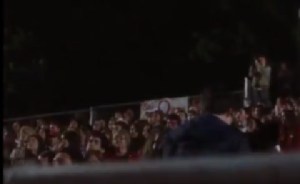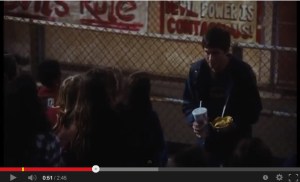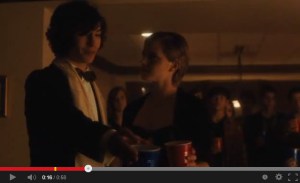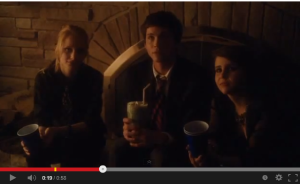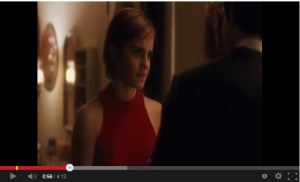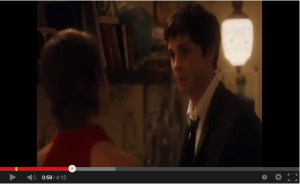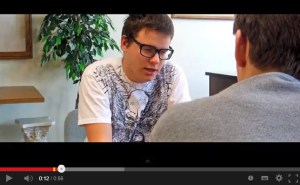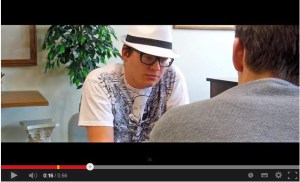Preliminary Task
Look Up – Remake
Coursework – Planning and Research
Camera Techniques
Editing Techniques
http://ejgcsasmedia.blogspot.co.uk/2011/04/editing-terms.html?m=1 – Editing definitions
http://prezi.com/s2kuc5-okxhe/?utm_campaign=share&utm_medium=copy&rc=ex0share
Sound
Preliminary Task: What is continuity? (Work produced by Louise Tindall)
Continuity is the consistency of characters, objects and places seen by the audience in between different shots. A good use of continuity would present an uninterrupted, coherent flow which would make it easier to watch and would stop any “jumping” between the different cuts. An example of this would be if in one shot somebody was shown starting to open a door and then in the following shot is cut into a scene where the door is shut again; this would disrupt a constant flow. A strong continuity is vital for all audiences, particularly passive audiences as the idea of a film or tv programme is to provide enjoyment and if there is constant jumping between the cuts it will lose its appeal to the audience.
Why is it important?
Continuity is important in order to create a well flowing piece of media. Without a consistent flow between cuts it will provide an unenjoyable viewing for the audience as they will be constantly going backwards and forwards between different takes either seeing the same thing twice or missing things inbetween. When filming a tv show or a film the recording of scenes is usually done over a period of weeks, not all in one day. This means that it is harder to get a strong continuity and they will most likely have to do a series of different takes before they are able to edit it with a good continuity. Without a strong continuity the audience will probably become less interested in what they are watching as they are always having to think about what is going on between each shot rather than just being able to enjoy it.
Three effects:
There are three different effects that can be used in order to achieve a good continuity between cuts. These are:
Match on action
180 degree rule
Shot reverse shot
Match on action:
Match on action is the continuing piece of action between different cuts. It makes sure that the scenes follow on from each other giving it a good continuity rather than them jumping backwards and forwards. Match on action is vital in order for the continuity to work and it can often rely on many takes before it is good enough to provide a constant flow. The idea of a match on action is to take the audiences attention away from the cutting between each shot and is to create a “visual bridge”.
An example of match on action is in this clip from “The Perks Of Being A Wallflower”:
As you can see here the main character Charlie is seen beginning to walk up the stairs.
It is then straight away cut into another scene where he is viewed from a different angle continuing to walk up the stairs.
This is an example of a match on action because the same action is being continued from two different shots. As we can see in both shots he is continuing up the same step and hasn’t jumped from being at the bottom to being halfway up the top. This provides a continuous flow because it is carrying on with no break in between.
180 degree rule:
The 180 degree rule is sort of like an imaginary semi circle which the camera is restricted to. The camera stays roughly at the same height and switches between two shots providing a view point, for example if two people were having a conversation you would switch from one person talking to the other without moving outside of this imaginary semi circle. The semi circle is important because if it was to go to outside this area to the 360 degree angle the characters would appear at different sides of the screen which would confuse the audience and would stop the flow from appearing constant. It provides the audience with a greater sense of location.
An example of this in “The Perks Of Being A Wallflower” is:
In this clip Patrick is making a toast to the main character Charlie and the camera switches between who is talking constantly.
Below we can see the camera is focused on Patrick talking and we are seeing the viewpoint from the character Charlie as it is positioned at a low angle looking up at Patrick because Charlie is currently sat down. The camera isn’t directly looking at Patrick because otherwise it would look like he was talking to us rather than Charlie.
The camera then switches to look at Charlie and the camera this time is positioned at a high angle looking down at Charlie because we are seeing it from Patrick’s perspective.
This is an example of the 18o degree rule because as the camera switches backwards and forwards between the conversation of Charlie and Patrick it stays at the left hand side of the scene so it appears that Charlie is sat down on the right hand side of the screen and Patrick is standing up on the left. If the camera broke the 180 degree rule they would appear on the opposite side confusing the audience.
Shot Reverse Shot:
This is a technique that is mainly used when two characters on screen are having a conversation. Us as an audience are able to see what the character is seeing. It is usually used with an over the shoulder shot. The camera switches between who is talking making it easy for the audience to keep up with what is going on. This also links in with the 180 degree rule as whilst the characters are having a conversation the camera has to stay at the same side within the imaginary semi circle otherwise once again the characters would appear on different sides of the screen.
An example of the shot reverse shot being used in “The Perks Of Being A Wallflower” is:
Here we are seeing the character Sam from Charlie’s viewpoint. As you can see it is using a over the shoulder shot making it look like we are looking into the conversation rather than as though we are taking part in it which is what it would look like if we were looking directly at the characters.
It then switches so we are seeing Charlie from Sam’s viewpoint. It does this continuously throughout the conversation. Also you can see it is including the 180 degree rule because the camera stays on the same side of the “semi circle”.
What happens if they are not used properly?
If the three techniques above are not used correctly the film becomes very jumpy and appears to be “stopping and starting” rather than providing a continuous and constant flow. If used incorrectly the audience are less likely to enjoy watching the film or programme as they will constantly be having to think about what is happening and having to “fill in the blanks” rather than just being able to relax whilst watching it.
Here is a video clip that emphasizes bad continuity:
An example within this clip is this:
In the following cut he is wearing a hat:
This provides a disruption in the continuity because something is changing within each shot, in this example it is the fact that he suddenly appears wearing a hat and then in another shot it has disappeared again. Although this clip was done on purpose to emphasize bad continuity it still shows just how important it is to have a strong continuity because otherwise it makes the scene less able to enjoy.
Getting a strong continuity is difficult because the shots are recorded within week periods making it difficult to get things to look exactly the same and to make it flow however it is really important to get it right if the media is to be enjoyed.
Evaluation Questions:
In the evaluation the following seven questions must be addressed
